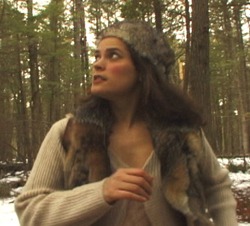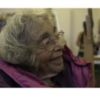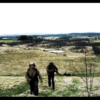
Acting | Company/Organization Profiles | Filmmaking | Interviews
Harvesting Stories
Written by Michael Colbert | Posted by: Anonymous
Words like "tilling, unearthing bones" and "humus" are not normally words associated with film production. But filmmaker Nicolle Littrell hopes that Film Farm, the production company she founded in Belfast, Maine, will become a nexus of support for other grassroots producers desiring to create Maine-based work. Meanwhile, Littrell turns the soil for local stories, sifts through the rich earth of forgotten lore and pulls up the bones that she hopes will speak to us.
Set in the turn-of-the-century backwoods Maine, Nicolle Littrell’s first film, "Trap" tells the story of the twisted relationship between a retired ballerina and a trapper. A New York City actress turned filmmaker, Littrell got tired of doing TV commercials. She brought her big city skills to Maine, where she said she desired to tell regional stories about real people. She shot the project on DV, and while only 15 minutes long, she had to set up a second screening on opening night to accommodate the crowds. Her organization, Film Farm, is all about grassroots production, grassroots stories and grassroots exhibition.
Although "Trap" takes place in the past, it explores a very modern theme — the co-dependent relationship. Along with the big city, Littrell said she left just such a relationship behind her. She found her way to Maine, where road signs for towns like Liberty, Friendship and Hope intrigued her.
MC: Matthew Heintz seems perfect for the Trapper’s role — the beard, the eyes that don’t seem to miss a trick, the whole mountain man look. How did you find him?
Littrell: My costume designer, Meredith Alex, first told me about him. She said he was a trapper/hunter/woodsman that was also a performer. He sounded too good to be true! The minute after I got off the phone with her, I called him. We set up a rendezvous for later that morning. We had just had a wicked ice storm, sleet everywhere. But my boyfriend, Rod, and I drove out through all of it to Matthew’s place in Thorndike. We spent most of our meeting in his shop, which is part museum, part craft-shop and part time travel capsule. It was an early American arts and crafts curator’s dream. Matthew beguiled us for about 2 hours weaving tales and playing show-and-tell with his packbaskets, scythes and leather masks. And of course, being known in these parts as the North Woods Balladeer, I made him sing a song. Recovering from a cold, he croaked out a ballad about trapping in Labrador. I was hooked. I had found my Trapper!
MC: What did you learn by making a silent film?
Littrell: I was looking for the point where people stop talking and start behaving. I thought telling a story would be easier without dialogue, but in some ways it’s more challenging. How do you convey all those emotions without getting hokey? Theater is a dialogue art; it was where I initially learned to act. But film images work differently.
MC: The story is told with images, innuendo…
Littrell: Yes. The shot of her running through the woods, escaping after the spring thaw — she’s pictured like a deer in the sights of a gun. Very vulnerable. And initially we had planned to shoot all the opening shots from a birds-eye point of view, but we were limited by budget. The feather falling into the rain barrel was my tribute to that. The style of course, is related to the main theme of the movie, the interplay of freedom and oppression.
MC: You’ve formerly talked about "unearthing bones." What did you mean by that?
Littrell: I look at myself as an archaeologist of sorts, unearthing stories from our past. I don’t want to be in New York or L.A. I like the regional approach to storytelling, stories that still have a sense of place. Maine is good for that. I’m especially interested in female role models, heroines, historical subjects. Especially women in Maine. I like the ones who break pre-conceived notions, the ones able to negate stereotype, the ones with the courage to develop their own voice.
MC: What future projects do you have in mind at Film Farm?
Littrell: I’m working on a piece about Molly Dellis, also known as "Spotted Elk." She was a Penobscot woman, born on Indian Island in 1903, a gifted dancer, an actress and a writer. She is described as having lived one of the most "amazing unknown lives of any 20th century American woman." She danced her way to New York and Paris and compiled a fantastic book of centuries-old Wabanaki folktales that is only now being published by the Maine Folk Life Center, through the University of Maine at Orono.
MC: What kind of appeal do you see these pieces having?
Littrell: As characters, they have universal appeal. But I’m not looking to go to Hollywood. I’m looking to bring the work to my own backyard. In the 1920’s in Maine a lot of films were made in the north woods, before the studio system. So there is a precedent. We’re doing it the old-fashioned way, outside of the studio system, and it’s a lot of fun. One of the things I hope to do is to bring these pieces to students. There’s such a lack of role models and heroines today.
MC: You once said that Film Farm is not only about grassroots production, but also about community. What did you mean by that?
Littrell: Storytelling helps us find our voice, release the voices of the past, and gets us all connected.
MC: You worked at the Museum of Modern Art (MOMA). What influence did that have on you?
Littrell: I worked as the Executive Assistant to the Chief Curator of the Department of Film and Video, Mary Lea Bandy. It was there that I met such cinematic luminaries as Jean Luc Godard, Peter Bogdanovic and others. But the biggest impression on me came from the silent films that surrounded me, all those faces from a bygone era, telling stories in a language not often spoken these days — silence.
MC: How did that affect your filmmaking?
Littrell: The films in the MOMA collection inspired me with an appreciation for telling stories through images only. And I was inspired by the great creativity at that time, in spite of small budgets and little experience — filmmaking was very young. And just the plain rugged adventurousness of it all! They would film in precarious circumstances. The melodramatic part of that era is certainly entertaining, but not what I was aiming for with TRAP.
MC: What was your final production cost?
Littrell: We spent six days shooting in April of 2002. All told, shooting, catering, editing — we came in at about $5,000. It was really a labor of love. We had a lot of help. The credits are almost as long as the movie!
MC: It takes a lot of people skill to pull off a low-budget production. What did you learn from this?
Littrell: I learned that people want to be a part of something, that they are willing to get out and support a good idea. In places like Maine, people seem to have more space to do their thing.
MC: One usually thinks of New York City as the place where people do their own thing.
Littrell: Believe it or not, people here not only have more physical space, but more psychic space. People have more elbow room, and they’re open to new ideas. Most transplants I encounter up here have chosen a new way of life and they’re happier for it. They want to be near the ocean, own an unspoiled piece of land, experience a real "Main Street," surround themselves with beauty — and follow their passions. The "space" empowers them to rekindle an old dream, try something they’ve always wanted to. And they’re more open to supporting and participating in other’s dreams. How many times have you encountered someone here that used to be an accountant, attorney, computer tech, waiter or ex-con that is now a painter, sculptor, boutique owner, B&B owner, filmmaker, writer or llama farmer? It’s astounding.
MC: If there were one thing you want to tell other filmmakers, what would it be?
Littrell: You can make something happen. If you have a dream, you can do it.
MC: If someone wanted to duplicate your effort in another part of New England — unearthing local stories that can be brought to life with grassroots production skills — what would you tell them?
Littrell: Keep your eyes, ears and heart open. Listen to what speaks to you, what’s in the wind. It’s all around. Pay attention to the road signs! Spend lots of time in dusty places — museums, historical societies, libraries. And talk to the elders of your community. They have a lot to share and can be a truly valuable resource. There are stories everywhere — you just have to find the ones that resonate with you, move you on a deeper level. Share your idea with others, talk it up — that’s the best way to find out who your kindred spirits are. It also gives the universe a chance to throw some bones back to you!
For more information about Nicolle Littrell and Film Farm, visit www.filmfarmmaine.com.











